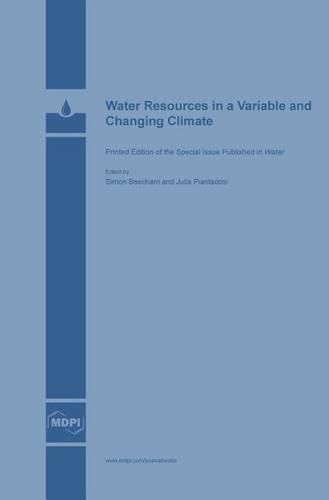Readings Newsletter
Become a Readings Member to make your shopping experience even easier.
Sign in or sign up for free!
You’re not far away from qualifying for FREE standard shipping within Australia
You’ve qualified for FREE standard shipping within Australia
The cart is loading…






This title is printed to order. This book may have been self-published. If so, we cannot guarantee the quality of the content. In the main most books will have gone through the editing process however some may not. We therefore suggest that you be aware of this before ordering this book. If in doubt check either the author or publisher’s details as we are unable to accept any returns unless they are faulty. Please contact us if you have any questions.
Climate change will bring about significant changes to the capacity of, and the demand on,
water resources. The resulting changes include increasing climate variability that is expected
to affect hydrologic conditions. The effects of climate variability on various meteorological
variables have been extensively observed in many regions around the world. Atmospheric
circulation, topography, land use and other regional features modify global changes to
produce unique patterns of change at the regional scale. As the future changes to these water
resources cannot be measured in the present, hydrological models are critical in the planning
required to adapt our water resource management strategies to future climate conditions.
Such models include catchment runoff models, reservoir management models, flood
prediction models, groundwater recharge and flow models, and crop water balance models. In
water-scarce regions such as Australia, urban water systems are particularly vulnerable to
rapid population growth and climate change. In the presence of climate change induced
uncertainty, urban water systems need to be more resilient and multi-sourced. Decreasing
volumetric rainfall trends have an effect on reservoir yield and operation practices. Severe
intensity rainfall events can cause failure of drainage system capacity and subsequent urban
flood inundation problems. Policy makers, end users and leading researchers need to work
together to develop a consistent approach to interpreting the effects of climate variability and
change on water resources.
This Special Edition includes papers by international experts who have investigated climate
change impacts on a variety of systems including irrigation and water markets, land use
changes and vegetation growth, lake water levels and quality and sea level rises. These
investigations have been conducted in many regions of the world including the USA, China,
East Africa, Australia, Taiwan and the Sultanate of Oman.
$9.00 standard shipping within Australia
FREE standard shipping within Australia for orders over $100.00
Express & International shipping calculated at checkout
This title is printed to order. This book may have been self-published. If so, we cannot guarantee the quality of the content. In the main most books will have gone through the editing process however some may not. We therefore suggest that you be aware of this before ordering this book. If in doubt check either the author or publisher’s details as we are unable to accept any returns unless they are faulty. Please contact us if you have any questions.
Climate change will bring about significant changes to the capacity of, and the demand on,
water resources. The resulting changes include increasing climate variability that is expected
to affect hydrologic conditions. The effects of climate variability on various meteorological
variables have been extensively observed in many regions around the world. Atmospheric
circulation, topography, land use and other regional features modify global changes to
produce unique patterns of change at the regional scale. As the future changes to these water
resources cannot be measured in the present, hydrological models are critical in the planning
required to adapt our water resource management strategies to future climate conditions.
Such models include catchment runoff models, reservoir management models, flood
prediction models, groundwater recharge and flow models, and crop water balance models. In
water-scarce regions such as Australia, urban water systems are particularly vulnerable to
rapid population growth and climate change. In the presence of climate change induced
uncertainty, urban water systems need to be more resilient and multi-sourced. Decreasing
volumetric rainfall trends have an effect on reservoir yield and operation practices. Severe
intensity rainfall events can cause failure of drainage system capacity and subsequent urban
flood inundation problems. Policy makers, end users and leading researchers need to work
together to develop a consistent approach to interpreting the effects of climate variability and
change on water resources.
This Special Edition includes papers by international experts who have investigated climate
change impacts on a variety of systems including irrigation and water markets, land use
changes and vegetation growth, lake water levels and quality and sea level rises. These
investigations have been conducted in many regions of the world including the USA, China,
East Africa, Australia, Taiwan and the Sultanate of Oman.